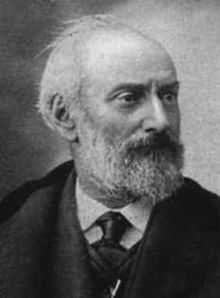Charles-Ange Laisant

Charles-Ange Laisant (1841–1920), French politician, was born at Indre,[1] near Nantes on 1 November 1841, and was educated at the École Polytechnique as a military engineer.
He defended the fort of Issy at the Siege of Paris, and served in Corsica and in Algeria in 1873. In 1876 he resigned his commission to enter the Chamber as deputy for Nantes in the republican interest, and in 1879 he became director of the Le Petit Parisien. For alleged libel on General Courtot de Cissey in this paper he was heavily fined.
In the Chamber he spoke chiefly on army questions; and was chairman of a commission appointed to consider army legislation, resigning in 1887 on the refusal of the Chamber to sanction the abolition of exemptions of any kind. He then became an adherent of the revisionist policy of General Boulanger and a member of the League of Patriots. He was elected Boulangist deputy for the 18th Parisian arrondissement in 1889. He did not seek re-election in 1893, but devoted himself thenceforward to mathematics, helping to make known in France the theories of Giusto Bellavitis. He was attached to the staff of the École Polytechnique, and in 1903–1904 was president of the French Association for the Advancement of Science.
In addition to his political pamphlets Pourquoi et comment je suis Boulangiste (1887) and L'Anarchie bourgeoise (1887), he published mathematical works, among them Introduction à la Méthode des Quaternions (1881) and Théorie et applications des equipollences (1887). He also co-founded a mathematical journal, L'Intermédiaire des Mathématiciens with Émile Lemoine in 1894, and was in 1888 the president of the Société Mathématique de France.[2]
He co-founded with Henri Fehr in 1899 a pedagogical journal, "L'Enseignement Mathématique". This journal was at their time an expression of the pedagogical ideas of both educators.[3]
See also
- Laisant's recurrence formula for the ménage numbers
References
- ↑ Registration of birth : cf. French page
- ↑ Anciens Présidents de la SMF — 1873–2006.
- ↑ One Hundred Years of "L'Enseignement Mathématique, Symposium of the EM-ICMI Symposium, 20-22 October 2000. Geneva: L'Enseignement Mathématique. 2003.,
![]() This article incorporates text from a publication now in the public domain: Chisholm, Hugh, ed. (1911). Encyclopædia Britannica (11th ed.). Cambridge University Press
This article incorporates text from a publication now in the public domain: Chisholm, Hugh, ed. (1911). Encyclopædia Britannica (11th ed.). Cambridge University Press
|